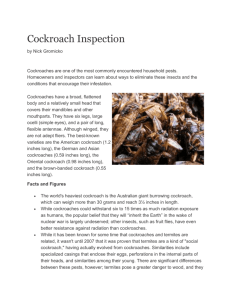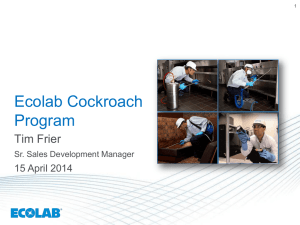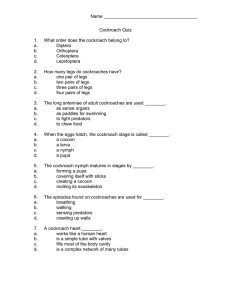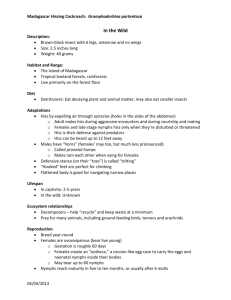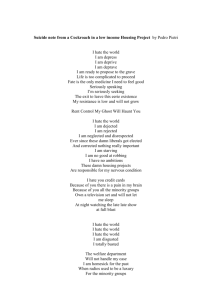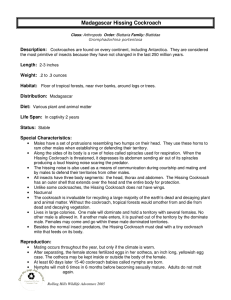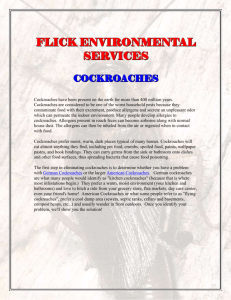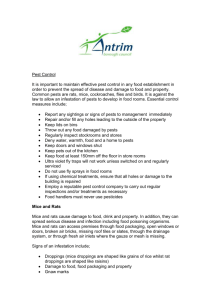Cockroaches and Their Management 1
advertisement
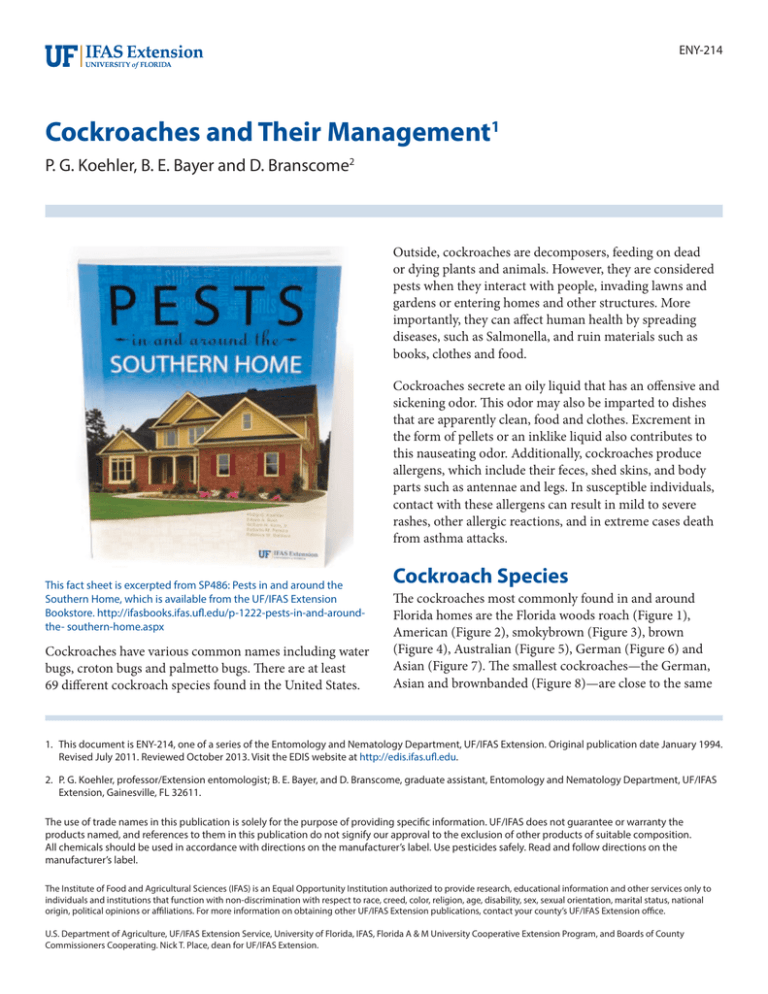
ENY-214 Cockroaches and Their Management1 P. G. Koehler, B. E. Bayer and D. Branscome2 Outside, cockroaches are decomposers, feeding on dead or dying plants and animals. However, they are considered pests when they interact with people, invading lawns and gardens or entering homes and other structures. More importantly, they can affect human health by spreading diseases, such as Salmonella, and ruin materials such as books, clothes and food. Cockroaches secrete an oily liquid that has an offensive and sickening odor. This odor may also be imparted to dishes that are apparently clean, food and clothes. Excrement in the form of pellets or an inklike liquid also contributes to this nauseating odor. Additionally, cockroaches produce allergens, which include their feces, shed skins, and body parts such as antennae and legs. In susceptible individuals, contact with these allergens can result in mild to severe rashes, other allergic reactions, and in extreme cases death from asthma attacks. This fact sheet is excerpted from SP486: Pests in and around the Southern Home, which is available from the UF/IFAS Extension Bookstore. http://ifasbooks.ifas.ufl.edu/p-1222-pests-in-and-aroundthe- southern-home.aspx Cockroaches have various common names including water bugs, croton bugs and palmetto bugs. There are at least 69 different cockroach species found in the United States. Cockroach Species The cockroaches most commonly found in and around Florida homes are the Florida woods roach (Figure 1), American (Figure 2), smokybrown (Figure 3), brown (Figure 4), Australian (Figure 5), German (Figure 6) and Asian (Figure 7). The smallest cockroaches—the German, Asian and brownbanded (Figure 8)—are close to the same 1. This document is ENY-214, one of a series of the Entomology and Nematology Department, UF/IFAS Extension. Original publication date January 1994. Revised July 2011. Reviewed October 2013. Visit the EDIS website at http://edis.ifas.ufl.edu. 2. P. G. Koehler, professor/Extension entomologist; B. E. Bayer, and D. Branscome, graduate assistant, Entomology and Nematology Department, UF/IFAS Extension, Gainesville, FL 32611. The use of trade names in this publication is solely for the purpose of providing specific information. UF/IFAS does not guarantee or warranty the products named, and references to them in this publication do not signify our approval to the exclusion of other products of suitable composition. All chemicals should be used in accordance with directions on the manufacturer’s label. Use pesticides safely. Read and follow directions on the manufacturer’s label. The Institute of Food and Agricultural Sciences (IFAS) is an Equal Opportunity Institution authorized to provide research, educational information and other services only to individuals and institutions that function with non-discrimination with respect to race, creed, color, religion, age, disability, sex, sexual orientation, marital status, national origin, political opinions or affiliations. For more information on obtaining other UF/IFAS Extension publications, contact your county’s UF/IFAS Extension office. U.S. Department of Agriculture, UF/IFAS Extension Service, University of Florida, IFAS, Florida A & M University Cooperative Extension Program, and Boards of County Commissioners Cooperating. Nick T. Place, dean for UF/IFAS Extension. size, and the adults are seldom more than 5/8 inch long (16mm). The larger cockroaches—American, Australian, brown, and the smokybrown—are 1–1/4 to 2 inches (31–51 mm) long and are often called palmetto bugs. Though they are generally found outdoors, they can become indoor problems when they migrate or are carried indoors. The largest cockroach, the Florida woods roach, will also enter dwellings from outside. Outdoor cockroaches do not survive well indoors, and many times people overreact to the presence of these cockroaches. Often, removal of these outdoor cockroaches from the house is all that is needed for control. Figure 3. Smokybrown cockroach egg case, adult and nymph. Adult actual size 1-3/4” (44.5 mm). Figure 1. Florida woods cockroach and egg case. Adult actual size 1-1/4” (31.75 mm). Figure 4. Brown cockroach adult, actual size, 1-1/2” (38 mm). Figure 2. American cockroach egg case, adult and nymph. Adult actual size 1-1/2” (38 mm). The Asian cockroach looks very much like a German cockroach, except it flies. Asian cockroaches live outside and are attracted to the lights from buildings. They will fly to porch lights and find their way inside. Once inside, however, their survival is poor, like other outdoor cockroaches. Cockroaches and Their Management Figure 5. Australian cockroach adult, actual size 1-1/2” (38mm). 2 Development of the Cockroach Cockroaches have three life stages: egg, nymph and adult. Cockroach eggs are deposited in groups in a leathery case or capsule called an ootheca. This capsule is usually dropped or glued to some surface by the female soon after it is formed. However, the female German cockroach carries the capsule protruding from her body until the eggs are ready to hatch. There may be from 30 to 48 eggs in the capsule of the German cockroach, but capsules of other cockroaches may have only 10 to 28 eggs. Figure 6. German cockroach male, female, nymph, and egg case. Adult actual size 5/8” (16 mm). The newly hatched nymphs have no wings and shed their skins (molt) several times before becoming winged adults. German and brownbanded cockroaches may have several generations per year, but the outdoor species may require a year to develop from egg to adult. Where to Look for Cockroaches Cockroaches hide in dark, sheltered places during the day and come out to feed at night. Inside, they may be found around the kitchen sink or drain board, in cracks around or underneath cupboards and cabinets or inside them (especially in the upper corners), behind drawers, around pipes or conduits (where they pass along the wall or go through it), behind window or door frames, behind loose baseboards or molding strips, on the underside of tables and chairs, in the bathroom, and in radio and TV cabinets. Figure 7. Asian cockroach male and female. Adult actual size 5/8” (16 mm). The German cockroach is usually found in the kitchen and bathroom, although it may be found all over the house. The other cockroaches prefer damp, warm places and usually develop in garages, sewers, attics, storerooms and similar locations, and then enter the home from outside breeding sites. Outside, cockroaches can be found in leaf litter, mulch, under vegetation, in tree holes, and in palm trees. Methods of Cockroach Control An integrated pest management (IPM) approach is the most effective method of cockroach control. Chemical use alone is the least effective control method. Using chemicals alone can result in insecticide resistance and, ultimately, very poor control. Figure 8. Brownbanded cockroach male, female, nymph, and egg case. Adult actual size, 3/4” (19 mm). Cockroaches and Their Management Homeowners may undertake their own IPM plan for cockroach control with good success, or they may elect to contract the services of a professional pest control operator. Professionals have the equipment and training to do a thorough job and have access to products not available 3 to homeowners. If you decide to contract the services of a professional pest control operator, get estimates from several reputable firms before you decide on one. Prevention and Sanitation Successful cockroach control requires prevention and sanitation. Vacuuming will eliminate cockroach skins and feces that cause cockroach allergies. Cockroach feces also contain a chemical (aggregation pheromone) that attracts cockroaches to an area. Eliminating the cockroach feces by scrubbing with hot, soapy water will decrease the amount of aggregation pheromone available to attract cockroaches to the area. Prevention and sanitation can be divided into four categories: exclusion; and elimination of water, food and harborage. Following the recommendations in the four categories will likely eliminate the most important factors that affect cockroach establishment. EXCLUSION • German cockroaches can initially infest a structure when infested grocery bags are brought inside. Inspect groceries for cockroaches before storing. Keep grocery bags in outside storage areas. • Cockroaches breed prolifically in corrugated cardboard boxes. Discard unnecessary boxes immediately. • Keep doors and windows shut. • Keep window and soffit screens in good repair to prevent cockroaches from entering your home. • Check attic vents and make sure that large openings around outside drainage lines and sewer vents are screened or sealed. Use tightly packed steel wool as a temporary filler until openings can be sealed properly. • Caulk or otherwise seal cracks and gaps around frames of doors and windows and around plumbing and electrical to help prevent cockroaches from entering your home. • Seal gaps between door frames and doors with weather stripping. apartment, infesting a “clean” dwelling. To help prevent this, caulk holes in common walls and around plumbing. ELIMINATION OF WATER SOURCES Water is the most important factor in cockroach survival. German cockroaches can survive only 12 days with food but no water. However, if only water is present with no food, cockroaches can survive for about 42 days. Cockroaches often come indoors during periods of drought because they are looking for moisture. Eliminate water sources by doing the following: • Repair plumbing leaks by tightening connections or patching leaky pipes, especially in kitchen and bathroom areas. • Do not let water stand in sinks for long periods of time. • Do not overwater indoor plants because accumulated water will be available to cockroaches. • Empty pans under refrigerators used to catch water from condensation. • Be aware that pet drinking dishes, aquaria and pipe condensation (under sinks, in wall voids) can also be sources of moisture. • Eliminate places outside where water can collect, such as cans, tires and tree holes. ELIMINATION OF FOOD SOURCES Cockroaches do not need large amounts of food to survive, especially in the presence of water, but availability of food can cause populations to increase rapidly. Furthermore, food sources compete with cockroach baits, decreasing their effectiveness. Elimination of food sources includes: • Store and dispose of garbage properly. The highest concentration of cockroaches in a home is usually around the garbage can and around the refrigerator. • Seal garbage can lids to prevent cockroaches from accessing food sources. Also, keep garbage areas clean by wiping frequently. • Dump sink strainers frequently to prevent food buildup. • Children can transport cockroaches from school to home in book bags and lunch containers. Inspect these items regularly. • Wipe off counters tops often. • Dwellings such as apartments that are separated by a common wall are particularly difficult situations. An infestation can migrate between apartments via the plumbing within a common wall. Therefore, cockroaches from one apartment can easily migrate to another • Keep kitchen appliances such as toasters, toaster ovens, microwaves, stoves, ovens, and refrigerators free of crumbs and other food debris. In addition, clean the areas around these appliances. Cockroaches and Their Management • Wash dishes immediately after use. Dishes left unwashed are a major source of food for a kitchen infestation. 4 • Reseal all food after opening, place in a tightly sealed container or store in the refrigerator. • Seal pet food tightly. Do not leave food and water out all the time. • Regularly vacuum or sweep under and around furniture where people eat, such as the dining room table. Vacuuming can also remove cockroach egg cases that will not be killed by insecticides. Remember to promptly dispose of the vacuum cleaner bag in an outdoor container. ELIMINATION OF HARBORAGES In addition to food and moisture, cockroaches require a place to live. The cockroach harborage is critical to its survival. Cockroaches prefer dark places that are warm and moist. Places that provide tight spaces such as stacks of newspaper or cardboard, piles of clothing, or cracks and crevices in structures are ideal harborages for cockroaches. Harborages not only provide a place for cockroaches to live, but they also can create “pesticide free” zones where cockroaches can hide if insecticides are selected as one tactic in the IPM program. Eliminate harborages by doing the following: • Seal cracks and crevices. Adult cockroaches can fit into cracks only about 1/16 inch and prefer spaces of about 3/8 inch. • Pull mulch away from the house. The large, outdoor cockroaches breed prolifically in pine straw mulch and poorly in gravel or on bare soil. • Stack firewood off the ground and well away from the house. • Fill tree holes with cement to remove this prime harborage area. • Keep shrubbery and ornamentals well trimmed and away from the house. Ivy is a favorite breeding place for outdoor cockroaches. • Keep clutter such as newspapers, bags, and clothing from accumulating. Chemical Control Use prevention and sanitation methods before and concurrently with chemical control tactics. The most commonly used chemical formulations for cockroach control are baits, sprays, and dusts. While cockroach foggers are commonly seen in the marketplace, their effect is limited to the cockroaches that directly contact the fog. Thus, control from foggers is variable and will not be discussed here. BAITS Baits are most highly recommended because of their effectiveness and targeted application, while decreasing unnecessary pesticide exposure. Baits usually come in granular formulations, plastic stations, or large syringes for gel applications. • Apply granular formulations outside in plants and mulched areas. • Bait stations are most effective when placed around corners where you suspect cockroaches are hiding or coming into your home. • Get small stations for German cockroaches and large stations for the larger outdoor cockroaches. • Place the gel bait in cracks and crevices around windows, doors, and any other suspected cockroach harborage, except in food handling areas. • Never spray a liquid insecticide where baits have been applied. Liquid insecticides used in the vicinity of baits will repel cockroaches from the bait. • Pest control operators have other baits in different forms that also provide long-lasting control. INSECT GROWTH REGULATOR • Insect growth regulators (IGR) require four to six weeks for a noticeable decrease in the cockroach population. But control is longer lasting than other contact insecticides because the cockroaches are no longer able to reproduce once exposed. Evidence of IGR exposure are twisted wings on the adult cockroaches and altered behavior. Expect to see more cockroaches during the day as a result of IGR use. Seeing more cockroaches after IGR use means the treatment is working. Baits can be used in conjunction with IGRs. SPRAYS • Greasy surfaces decrease the effectiveness of insecticide applications. Therefore, before treating surfaces, eliminate grease and oil by scrubbing with hot, soapy water. • Generally, liquid sprays will not be effective when applied to wood surfaces such as cabinets and shelves. • Apply materials to cracks and crevices where cockroaches live. These areas include cracks around pipes under sinks, around toilet bowls, around baseboards, and around appliances. • Never spray around or into electrical outlets. • Sprays are effective for controlling exposed insects. • Avoid spraying food preparation surfaces. Cockroaches and Their Management 5 • Do not touch surfaces until dry (at least 4 hours). • Some materials may damage carpets, tile, or plastics. Check the label before using any material on these surfaces. • Outdoor products should be applied at the label rate to cracks and crevices where cockroaches are suspected of living or entering the home, such as door thresholds and window frames. • A perimeter treatment along the base of the foundation wall, in cracks and crevices, and at points of entry into the home can also help control the larger outdoor cockroaches. Sealing cracks and crevices is recommended prior to the spray treatment. DUSTS An IPM Approach for Outdoor Cockroaches An 80% or better reduction in cockroach abundance can be achieved using the following IPM approach. Use only a thin layer of mulch around the home that extends 1 foot out from the foundation. This will allow drying time and make conditions less conducive to cockroach survival. Apply control products within 3 feet of the home in pine straw, fallen leaves, or ivy, and next to other cockroach habitats such as garden borders, large rocks, or railroad ties. Always follow the label. Dusts are slow-acting but can give long-lasting control. Boric acid is probably the most commonly used dust labeled for cockroach control. It is most effective indoors in clean, dry areas. Treat sheltered cracks and crevices such as porch corners, under ledges, in crawl space gratings, and under garage doors. Baits or liquid products can be used, but not both at the same time in the same place. • Apply boric acid with a duster that puts out a thin film of dust. Precautions • Apply dusts in hidden areas such as under refrigerators, stoves, sinks, wall voids, and other cracks and crevices. • Do not apply dusts in open areas such as on shelves or counters where food and utensils are kept. • Boric acid is highly toxic to plants and will discolor some fabrics. All insecticides are poisons. Read the entire label, including the small print before opening the containers and heed all warnings and cautions. Store pesticides in their original labeled containers out of reach of children, irresponsible people, and pets, and preferably keep under lock and key. Dispose of leftover spray materials and empty containers promptly and safely. • Other effective dust and borate products are available to pest control operators. IPM Approach for Indoor Cockroaches • Thoroughly vacuum and wipe the premises with hot soapy water. • Place baits (gel and station type) according to label directions. • Check baits monthly until populations decrease, then quarterly. • Replace empty bait stations because they provide additional harborage for cockroaches when empty. • If populations are very high, a “clean-out” may be needed to knock down the initial population. Use a liquid insecticide mixed with an insect growth regulator, such as hydroprene or pyriproxyfen, in cracks and crevices. • Place baits in areas not treated with liquid insecticide or place baits four to six weeks after spraying. Cockroaches and Their Management 6

